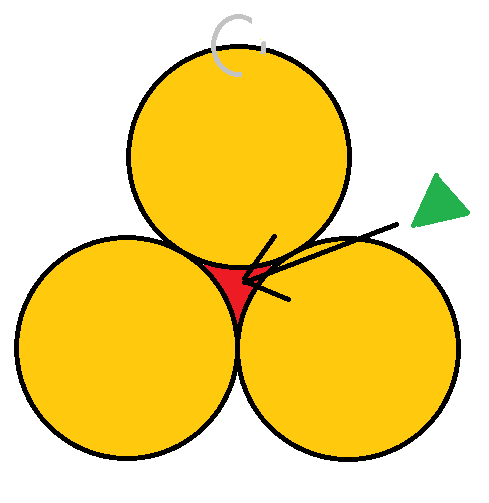Jewellers problem

A Jeweller wants to maximize the area of a triangular emerald within his earring. He uses three touching circles as a geometrical model of the earring.
If the radius of all three circles is 12 , what is the maximum possible area of the triangle that fits within the red region?
Give answers to one decimal place.
Bonus: Can you prove that your answer is a maximum?
The answer is 17.90721403.
This section requires Javascript.
You are seeing this because something didn't load right. We suggest you, (a) try
refreshing the page, (b) enabling javascript if it is disabled on your browser and,
finally, (c)
loading the
non-javascript version of this page
. We're sorry about the hassle.
2 solutions
Because of symmetry the required triangle XYZ and the triangle joining centers ABC will both be equilateral and will have the same point G as incenter and circumcenter of both the triangles. The XYZ will be tangential to all three circles and its inradius is say r.
So the sides of XYZ are perpendicular to the circumradius of the ABC.
This circumradius of ABC, with sides 2 * 12 =24, is
1
2
∗
3
2
= radius of the circles + incenter of XYZ=12+ r.
So r=
1
2
∗
3
2
−
1
2
=
1
2
∗
(
3
2
−
1
)
.
So the area of XYZ=
2
1
∗
(
3
r
)
2
∗
3
2
=
1
7
.
9
0
7
since it is an equilateral triangle.
Equal radii creates outer equilateral triangle.
The green triangle is tangent to all three circles. Hence the right angles drawn within the green triangle.
The angle between the circumcenter of the green triangle and the bottom of the red region is 30 degrees when the area of the green triangle is maximised. You can work this out intuitively as the width of the green triangle decreases below 30 degrees and the height decreases beyond 30 degrees but at 30 degrees, there is an equilibrium and the area is maximised.
Let d = distance between circumcenter of green triangle and the point at which the tangent meets the circumferences.
After we obtain d, we also notice that the triangle can be split into 6 congruent triangles.
So we do the area of one triangle x 6 to get the area.
Hence,
d = -12 + 8sqrt(3)
Max area of green triangle = 6(0.5 * d * dtan(60)) = 3d^2 * tan(60) = 17.9.
Extra: I also made a model of the area of the green triangle as you change the angle between the circumcenter of the green triangle and the bottom of the red region given that all sides remain tangent to the circles. http://www.geogebra.org/m/QSpRfRyh (This was after algebraically proving it.)
Please like and follow. :)